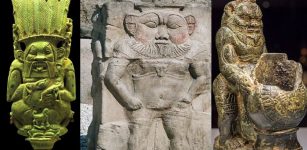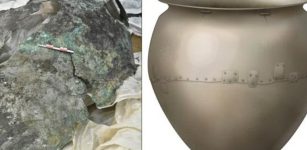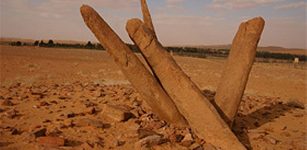‘Bad King John’ Of England: His Lost Treasures Have Never Been Found
A. Sutherland - AncientPages.com - The legend of King John's lost treasure has been handed down from generation to generation.
However, it is not only a legend.
John was King of England from 1199–1216. He proved to be a total failure as a ruler. Between 1202 and 1204, the King of France managed to capture most of the lands in France held by John. Afterward, John was given the nickname 'soft sword.'
He acted King from 1189 when his brother Richard the Lion-Heart was on the Third Crusade.
'Lackland' was John's other nickname, most probably because, as the youngest of Henry II's five sons, it was challenging to find a portion of his father's French possessions for him to inherit.
Involved in intrigues against his absent brother, John eventually became King in 1199 when Richard the Lionheart was killed in battle in France. After that, he was portrayed as 'Bad King John.'
Ancient sources say that John ruled like a tyrant. To pay for the war with France, he raised taxes – imposing a special tax on Jews – and enforced feudal prerogatives. He was accused of extorting money from people and selling offices.
King John's Tomb, Worcester Cathedral Set before the high altar, his tomb is made of dark Purbeck marble topped with an effigy. When King John lay dying of his famous "surfeit of peaches" in 1216, he asked to be buried in Worcester Cathedral. Image credit: Bob Embleton - CC BY-SA 2.0
'Bad King John' had a great hobby: collecting jewelry. He was particularly fond of collecting (stealing) jewelry for himself and coinage for his guards and soldiers. He owned a hoard of gold and silver plates and other valuables, of which the most valuable were the imperial regalia he had inherited from his grandmother, the Empress of Germany.
On 12 October 1216, John lost all of his treasure when he tried to take a shortcut across a stretch of water in Wash, the large bay that separates East Anglia from Lincolnshire.
This particular region of marshes and mudflats was usually traversable at low tide but not otherwise. The tide rose faster than the King expected. He misjudged the power of the wave, leading to the advancing waters claiming his precious baggage train. John's baggage, which supposedly included all royal treasures, including the Crown Jewels and gold coins, was engulfed in a raging whirlpool.
King John of England, 1167-1216 on hunt. Public Domain
'Bad King John' lost everything. He died only a few days later, on 18 October 1216, at Newark.
What happened to John's treasure carts? Is John's treasure buried somewhere in the area of Sutton Bridge? Treasure hunters from the USA and England have attempted to locate the exact location of the incident. Even a team of researchers from Nottingham University took soil samples to shed some light on the incident in 1216.
The search goes on because, as you know, treasure hunters never lose hope of finding what they are looking for.
Written by – A. Sutherland - AncientPages.com Senior Staff Writer
Updated on March 27, 2024
Copyright © AncientPages.com All rights reserved. This material may not be published, broadcast, rewritten or redistributed in whole or part without the express written permission of AncientPages.com
Expand for referencesReferences:
T. Carte, A General History of England
Ralph V Turner, King John: England's Evil King?
More From Ancient Pages
-
 Archaeological Evidence Ancient Egyptians Visited South America
Ancient Mysteries | Jan 7, 2020
Archaeological Evidence Ancient Egyptians Visited South America
Ancient Mysteries | Jan 7, 2020 -
 6,000-Year-Old Earth Ovens Discovered In Washington State
Archaeology | Jun 21, 2023
6,000-Year-Old Earth Ovens Discovered In Washington State
Archaeology | Jun 21, 2023 -
 Was Mysterious 2,000-Year-Old Miniature Clay Token Used By Pilgrims Arriving To The Temple In Jerusalem?
Artifacts | Apr 26, 2024
Was Mysterious 2,000-Year-Old Miniature Clay Token Used By Pilgrims Arriving To The Temple In Jerusalem?
Artifacts | Apr 26, 2024 -
 Strange Case Of The Italian Doppelganger – A Tragedy – Part 1
Featured Stories | Oct 14, 2019
Strange Case Of The Italian Doppelganger – A Tragedy – Part 1
Featured Stories | Oct 14, 2019 -
 Giant Mimir And The Well Of Wisdom In Norse Beliefs
Featured Stories | Apr 11, 2018
Giant Mimir And The Well Of Wisdom In Norse Beliefs
Featured Stories | Apr 11, 2018 -
 Mystery Of The Gotland Grooves – Ancient Astronomical Observatory?
Civilizations | May 11, 2016
Mystery Of The Gotland Grooves – Ancient Astronomical Observatory?
Civilizations | May 11, 2016 -
 Bes – Ancient Egyptian Dwarf God Of Childbirth, Humor, Song and Dance
Egyptian Mythology | Sep 9, 2016
Bes – Ancient Egyptian Dwarf God Of Childbirth, Humor, Song and Dance
Egyptian Mythology | Sep 9, 2016 -
 Thousands Of Remarkable Megaliths On The Sumba Island
Featured Stories | Aug 30, 2017
Thousands Of Remarkable Megaliths On The Sumba Island
Featured Stories | Aug 30, 2017 -
 Evidence Humans Have Been Using Bear Skins For At Least 300,000 Years Discovered
Archaeology | Dec 27, 2022
Evidence Humans Have Been Using Bear Skins For At Least 300,000 Years Discovered
Archaeology | Dec 27, 2022 -
 Bronze Age Metal Cauldrons Show What Ancient People Ate
Archaeology | Aug 19, 2023
Bronze Age Metal Cauldrons Show What Ancient People Ate
Archaeology | Aug 19, 2023 -
 Mysterious Otherworldly Creatures Witnessed By Biblical Prophet – What Happened?
Ancient Mysteries | Jun 30, 2020
Mysterious Otherworldly Creatures Witnessed By Biblical Prophet – What Happened?
Ancient Mysteries | Jun 30, 2020 -
 Stones Of Rajajil – Sophisticated Road Markers Or An Ancient Astronomical Observatory?
Civilizations | May 21, 2017
Stones Of Rajajil – Sophisticated Road Markers Or An Ancient Astronomical Observatory?
Civilizations | May 21, 2017 -
 Dramatic Life Story Of Queen Marie Antoinette Executed By Guillotine During The French Revolution
Featured Stories | Oct 18, 2021
Dramatic Life Story Of Queen Marie Antoinette Executed By Guillotine During The French Revolution
Featured Stories | Oct 18, 2021 -
 Unexplained Mystery Of Secret Knowledge And Extraordinary Sightings Hidden In An Author’s Book
Featured Stories | Nov 25, 2021
Unexplained Mystery Of Secret Knowledge And Extraordinary Sightings Hidden In An Author’s Book
Featured Stories | Nov 25, 2021 -
 Denisovan DNA May Explain Why Tibetan Women Thrive In Low Oxygen At High Altitudes For Over 10,000 Years
DNA | Nov 18, 2024
Denisovan DNA May Explain Why Tibetan Women Thrive In Low Oxygen At High Altitudes For Over 10,000 Years
DNA | Nov 18, 2024 -
 Mysterious Coso Petroglyphs In California – Made By Whom And For What Reason?
Featured Stories | Dec 31, 2020
Mysterious Coso Petroglyphs In California – Made By Whom And For What Reason?
Featured Stories | Dec 31, 2020 -
 On This Day In History: Historical Scandal Took Place In France – On July 31, 1451
News | Jul 31, 2016
On This Day In History: Historical Scandal Took Place In France – On July 31, 1451
News | Jul 31, 2016 -
 Coronavirus: Advice From The Middle Ages For How To Cope With Self-Isolation
Featured Stories | Mar 29, 2020
Coronavirus: Advice From The Middle Ages For How To Cope With Self-Isolation
Featured Stories | Mar 29, 2020 -
 Spectacular Statue Of Sea God Triton Found In Roman Mausoleum In Kent
Archaeology | Sep 13, 2023
Spectacular Statue Of Sea God Triton Found In Roman Mausoleum In Kent
Archaeology | Sep 13, 2023 -
 Stunning Swiss Stonehenge Discovered Underwater
Archaeology | Nov 4, 2019
Stunning Swiss Stonehenge Discovered Underwater
Archaeology | Nov 4, 2019



